The Animal Kingdom is one of the largest groups used by scientists to organize living things on Earth. It includes millions of species, from tiny insects to giant whales. All animals share some common features: they are made of many cells, they can move on their own at some stage in life, and they need food to live because they cannot make their own food like plants do.
Scientists classify animals into different groups based on their body structure, how they grow, and how they reproduce. One of the biggest divisions is between vertebrates and invertebrates. Vertebrates are animals with a backbone, such as mammals, birds, fish, reptiles, and amphibians. Invertebrates are animals without a backbone, such as insects, worms, jellyfish, and octopuses.
Animals can also be grouped by other features. Some are warm-blooded, meaning they can keep their body temperature the same in all weather. Others are cold-blooded, meaning their body temperature changes with their surroundings. Some animals lay eggs, while others give birth to live young. The Animal Kingdom is incredibly diverse. Mammals have hair or fur and feed their babies with milk. Birds have feathers and can usually fly. Fish live in water and breathe through gills. Reptiles have dry, scaly skin, while amphibians can live both in water and on land.
Studying the Animal Kingdom helps us learn more about life on Earth. It shows us how animals adapt to their environments, how they interact with other living things, and how they survive. It also helps us understand the importance of protecting wildlife and keeping the balance of nature.
The Animal Kingdom is full of wonders, from the tiniest ant to the tallest giraffe, each with its own special way of living.
Ctenophora
- Nematocysts absent; tentacles (generally one pair) have adhesive cells called colloblasts (lasso cells) for capturing prey.
- Body unsegmented; body wall likely triploblastic. Epidermis ciliated; mesenchyme/mesoglea contains muscle fibres, connective tissue, and amoeboid cells.
- Polymorphism absent; statocyst (balancing organ) present.
- Asexual reproduction absent, but regeneration is strong.
- Hermaphrodite; gonads endodermal; fertilization external or internal.
Examples: Pleurobrachia, Ctenoplana
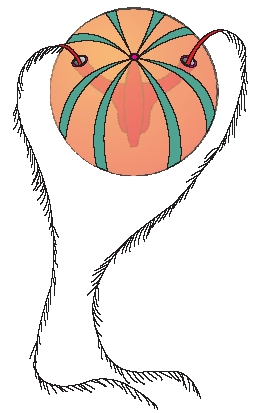
Platyhelminthes
- Flatworms; mostly parasites, some free‑living (e.g., Planaria).
- Acoelomate, triploblastic, bilaterally symmetrical, dorsoventrally flattened; organ‑system level of organization.
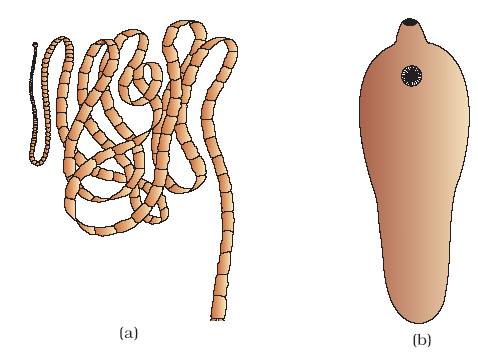
(a) Tape worm (b) Liver fluke
- Body segmented (false segmentation) in class Cestoda.
- Free‑living forms: one‑layered partly ciliated epidermis. Parasitic Trematoda & Cestoda lack epidermis; body covered with cuticle.
- No true exo/endoskeleton. Hooks, spines, suckers may occur as adhesive organs.
- Parenchyma fills space between body wall, gut, and organs; helps transport food.
- Digestive system absent in tapeworms; present in trematodes & turbellarians with mouth, pharynx, and blind intestine (anus absent).
- Excretion by protonephridia with flame cells.
- Ladder‑type nervous system: cerebral ganglia + longitudinal cords + transverse commissures.
- Sense organs common in Turbellaria; reduced in parasites.
- Mostly hermaphrodite. Asexual fission in many freshwater turbellarians.
- Eggs often lack yolk but have yolk cells; internal fertilization; development incomplete; complex life cycles with one or more hosts.
- Mostly endoparasites; planarians show high regeneration ability.
Examples: Taenia (tapeworm), Fasciola (liver fluke)
Classification — based on mode of life
| Class | Turbellaria | Trematoda (Flukes) | Cestoda (Tapeworms) |
| Character | Mostly free‑living | Ecto‑ or endoparasitic | Ecto‑ or endoparasites of vertebrates |
| Example | Planaria (Dugesia) | Fasciola (liver fluke), Schistosoma (blood fluke) | Taenia solium (pork), T. saginata (beef) |
Aschelminthes (Nemathelminthes / Roundworms)
- Cylindrical, circular in cross‑section; free‑living (aquatic/terrestrial) or parasitic.
- Bilaterally symmetrical, triploblastic, unsegmented; organ‑system organization.
- No appendages; tough cuticle (moulted 4 times) over syncytial, non‑ciliated epidermis; muscles longitudinal only.
- No mineralized skeleton; pseudocoelomic fluid pressure forms a hydroskeleton.
- Complete digestive tract (mouth to anus). Mouth with 3–6 lips bearing sensory papillae; muscular pharynx; non‑muscular intestine.
- Respiration by diffusion; nervous system with circumpharyngeal nerve ring and six longitudinal cords.
- Excretion via renette cells or H‑shaped canals.
- Sexual dimorphism common (males smaller). Internal fertilization; direct development; no asexual reproduction. Cleavage determinate & spiral.
Examples: Ascaris (roundworm), Ancylostoma (hookworm), Wuchereria (filarial worm)
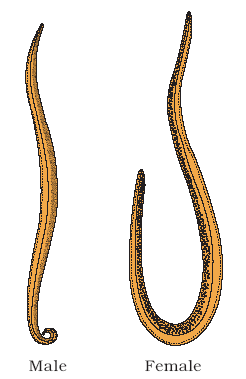
Male vs Female Ascaris
| Male | Female | |
|---|---|---|
| 1. | Smaller, with curved posterior end. | Larger, straight posterior end. |
| 2. | Two equal chitinous spicules (penial setae) project through cloaca. | Spicules absent. |
| 3. | Anus & genital aperture open into cloaca. | Separate anus and genital aperture (~1/3 from anterior); cloaca absent. |
Annelida
- Chitinous setae for locomotion (on parapodia in many); absent in leech.
- True schizocoelic coelom, compartmentalized by septa; coelomic fluid acts as hydrostatic skeleton.
- Complete digestive system; respiration cutaneous or via gills.
- Closed blood vascular system (no RBCs; respiratory pigments in plasma). Leeches lack a true BVS.
- Excretion by nephridia; ammonia is chief waste.
- Nervous system: nerve ring and double ventral nerve cord with segmental ganglia.
- Sensory: tactile organs, taste buds, statocysts, photoreceptors, eyes with lenses.
- Sexes separate (Nereis) or united (earthworm, leech). Development mostly direct; indirect with trochophore larva in Nereis.
Examples: Nereis, Pheretima (earthworm), Hirudinaria (leech)
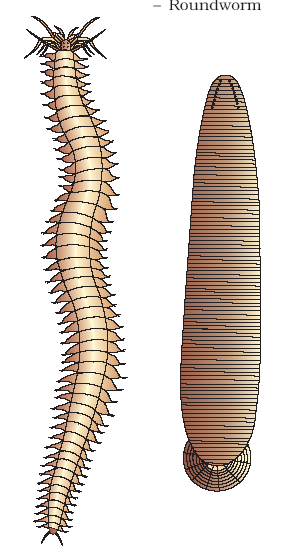
Classification — based on setae/parapodia
| Class | Polychaeta | Oligochaeta | Hirudinea |
| Character | Parapodia & numerous setae | Few setae, no parapodia | No parapodia/setae; ectoparasitic |
| Example | Nereis | Pheretima, Lumbricus, Megascolex | Hirudinaria, Pontobdella |
Also: Aphrodite (sea mouse), Serpula (fan worm)
Arthropoda
- Largest phylum (~900,000 species). Triploblastic, bilaterally symmetrical, metamerically segmented.
- Chitinous exoskeleton; paired jointed appendages. Body divided into head, thorax, abdomen (or cephalothorax + abdomen).
- True coelom reduced; haemocoel prominent.
- Well‑developed sense organs (compound eyes, statocysts).
- Complete digestive tract (foregut, midgut, hindgut); varied mouthparts.
- Respiration: gills/book gills (aquatic); tracheae/book lungs (terrestrial).
- Open circulatory system (dorsal heart, arteries, sinuses).
- Excretion: green glands, Malpighian tubules, or coxal glands.
- Nervous system: dorsal nerve ring; double ventral nerve cord.
- Endocrine glands present; insects use pheromones.
- Sexual dimorphism common; internal fertilization; oviparous/ovoviviparous; direct or indirect development; parthenogenesis in some.
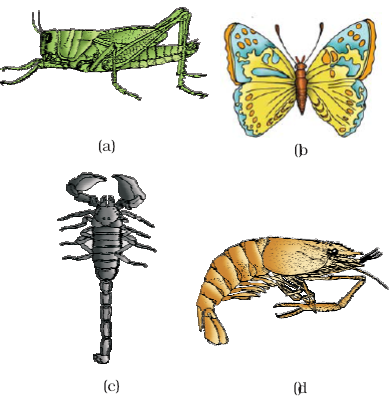
(a) Locust (b) Butterfly (c) Scorpion (d) Prawn
Economically important: Apis (honey bee), Bombyx (silkworm), Laccifer (lac insect)
Vectors: Anopheles, Culex, Aedes | Gregarious pest: Locusta (locust) | Living fossil: Limulus (king crab)
Classification — based on body division & appendages
| Class | Crustacea | Arachnida | Chilopoda | Diplopoda | Insecta (Hexapoda) | Onychophora |
| Character | C + A; two pairs of antennae; cephalothorax often with carapace | C + A; six pairs of appendages; no antennae | Head + trunk; each trunk segment with one pair of legs; poison claw | Head + thorax + abdomen; thoracic segments with 1 pair of legs; abdominal with 2 pairs | Head + thorax + abdomen; one pair antennae; thorax of 3 segments with 3 pairs of legs; usually 2 pairs of wings | Segmented worm‑like; unjointed legs |
| Example | Palaemon (prawn), Cancer (crab) | Scorpion, spider, tick, mite | Scolopendra (centipede) | Julus (millipede) | Cockroach, beetle, wasp, butterflies | Peripatus (walking worm) |
H – head, T – thorax, A – abdomen, C – cephalothorax
Mollusca
- Shell secreted by mantle: external (most), internal (slug, cuttlefish, squid), or absent (Octopus).
- Head distinct (except some classes) with eyes, tentacles, and other sense organs.
- Ventral body wall forms the muscular foot (for creeping, burrowing, swimming).
- Body cavity a haemocoel; true coelom largely limited to pericardium and small spaces in kidneys/gonads.
- Complete digestive tract; radula common (absent in Bivalvia). Gastropods/scaphopods/cephalopods often have a U‑shaped intestine.
- Respiration via ctenidia (gills), body surface, mantle, or lung (pulmonary sac).
- Open circulatory system with dorsal pulsatile heart; haemocyanin as pigment.
- Excretion by paired kidneys; gills may aid excretion; excretory matter often ammonia.
- Nervous system: paired cerebral, pleural, pedal, and visceral ganglia with connectives.
- Sense organs: eyes, tentacles, statocysts (equilibrium), osphradia (chemoreceptors).
- Larvae: trochophore, veliger, glochidium (varies by group).
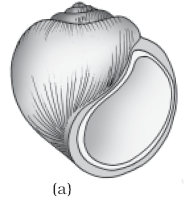
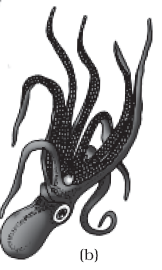
Classes of Mollusca — based on foot & shell
| Class | Monoplacophora | Polyplacophora (Amphineura) | Gastropoda | Bivalvia (Pelecypoda) | Scaphopoda | Cephalopoda |
| Character | One shell; segmented mollusc | Shell of 8 plates | Spirally coiled shell; largest class; torsion | Shell with two valves | Tubular shell | Shell internal (Sepia), external (Nautilus), or absent (Octopus) |
| Example | Neopilina (link between Annelida & Mollusca) | Chiton | Pila, Limax, Aplysia | Unio, Pinctada, Teredo | Dentalium | Sepia, Loligo, Octopus |
Echinodermata (Spiny‑bodied animals)
- Spines protective; pedicellariae keep the surface clean.
- Body unsegmented; shapes vary (globular, star‑like, spherical, discoidal, elongated); five ambulacra with alternating inter‑ambulacra.
- Body wall: single‑layered ciliated epidermis, dermis, peritoneum.
- Gut straight or coiled; Aristotle’s lantern (sea urchin) as masticatory apparatus.
- Respiration: dermal branchiae, tube feet, respiratory trees, bursae, or peristomial gills.
- Water vascular system (coelomic origin) with madreporite; tube feet for locomotion.
- Reduced open circulatory (hemal) system; no heart; excretion absent (diffusion via gills).
- Nervous system: nerve ring + radial nerves; no brain; simple sense organs.
- Reproduction: asexual & sexual; sexes usually separate; external fertilization; indirect development via free‑swimming larvae; resemble chordates in early embryology.
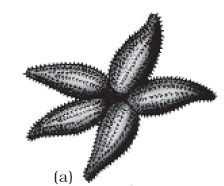
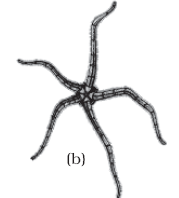
Classification — by body shape & larval form
| Class | Asteroidea | Ophiuroidea | Echinoidea | Holothuroidea | Crinoidea |
| Character | Star‑shaped; bipinnaria larva | Star‑shaped; pluteus larva | Globular; echinopluteus larva | Cucumber‑like; auricularia larva | Flower‑like; doliolaria larva |
| Example | Asterias | Ophiothrix | Echinus | Cucumaria | Antedon |
Phylum Hemichordata
- Small group of worm‑like marine animals with cylindrical body: proboscis, collar, and trunk.
- Open circulatory system; gill respiration; proboscis gland excretory.
- Sexes separate; external fertilization; indirect development.
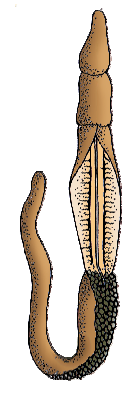
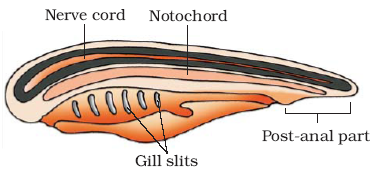
Examples: Balanoglossus, Saccoglossus
Phylum Chordata
- Presence of notochord; dorsal hollow nerve cord; paired pharyngeal gill slits; post‑anal tail; endostyle/thyroid; mostly closed circulation.
- Cyclostomes, Pisces, Amphibia, and Reptilia are poikilotherms; Aves and Mammalia are homeotherms.
Overview
| Chordata | ||||
|---|---|---|---|---|
| Protochordata / Acraniata (marine) | Vertebrata / Craniata (aquatic & terrestrial) | |||
| Urochordata / Tunicata / Ascidians Notochord in larval tail only. |
Cephalochordata Notochord from head to tail, persistent throughout life; typical chordates. |
Notochord present in embryo, replaced by cartilaginous/bony vertebral column; ventral heart; kidneys; paired appendages (fins/limbs). | ||
| Vertebrata | ||||
| Agnatha (jawless) → Class Cyclostomata | Gnathostomata (jawed) | |||
| Ectoparasitic on fishes (some); circular suctorial mouth (jawless); 6–15 pairs of gill slits; scaleless skin; median unpaired fins; cartilaginous cranium & vertebral column; closed circulation with 2‑chambered heart. | Pisces Fins & dermal scales; 2‑chambered heart. |
Tetrapoda Two pairs of pentadactyl limbs; epidermal hair/feathers/scales; 3 or 4‑chambered heart. |
||
| A jawless vertebrate — Petromyzon (sea lamprey) | ||||
Superclass Pisces
- Locomotion by fins; branchial respiration (gills); dermal scales; lateral line organs.
| Pisces | |
|---|---|
| Class Chondrichthyes (cartilaginous) | Class Osteichthyes (bony) |
| Always marine; placoid scales; cloaca; 5–7 gill slits without operculum; no swim bladder (continuous swimming); claspers as copulatory organ; usually internal fertilization; many oviparous, some viviparous. Examples: Scoliodon (dogfish), Pristis (sawfish), Carcharodon (great white shark), Trygon (sting ray) |
Marine or freshwater; ganoid/ctenoid/cycloid scales; anus present; 4 gill pairs with operculum; swim bladder present; claspers absent; usually external fertilization; generally oviparous. Examples: Marine — Exocoetus (flying fish), Hippocampus (seahorse); Freshwater — Labeo (rohu), Catla (katla), Clarias (magur); Aquarium — Betta (fighting fish), Pterophyllum (angelfish) |
Superclass Tetrapoda — Class 1: Amphibia
- Aquatic and terrestrial; some limbless (Ichthyophis), some tailed (salamander); moist scaleless skin.
Class 1: Amphibia
- Live in aquatic as well as terrestrial-habitats.
- Some are limbless (Ichthyophis)
- Some are with tail (Salamander)
- Moist skin, without scales.
- Presence of movable lower eyelids.
- Presence of tympanum, represents the ear.
- Presence of cloaca (common opening for the alimentary Canal, urinary and Reproductive tract).
- Three chambered heart.
- Sexes are separate, fertilization external (except few - Salamander).
- Oviparous
- Indirect development (tadpole larvae).
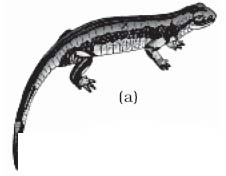
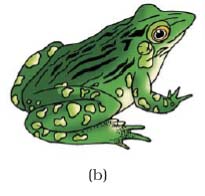
(a) Salamandra (b) Rana
Examples: Bufo (Toad), Rana (Frog), Hyla (Tree frog),Salamandra (Salamander), Ichthyophis (Limbless amphibian).
Class 2: Reptilia
- Cornified skin with scales/scutes; thoracic pulmonary breathing; amniotic eggs: key terrestrial adaptations.
- Creeping/crawling; tympanum present, no external ear; heart mostly 3‑chambered (4‑chambered in crocodiles); ecdysis in snakes/lizards; sexes separate; internal fertilization; usually oviparous; direct development.
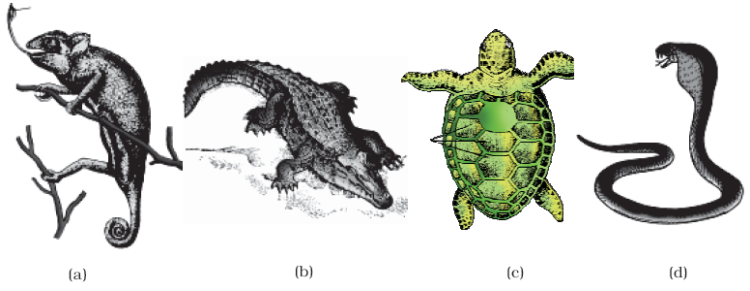
Examples: Chelone (turtle), Testudo (tortoise), Chameleon, Calotes (garden lizard), Crocodilus (crocodile), Alligator, Hemidactylus (wall lizard)
- Poisonous snakes: Cobra, Krait, Viper, Pit viper, Russell’s viper, Sea snake, Coral snake, Rattlesnake.
- Non‑poisonous snakes: Python, Typhlops (blind snake), Rat snake, Tree snake, Double‑headed snake.
- ~90% of snakes are non‑poisonous.
- Neurotoxic venom: acts on nervous system (Cobra, Krait, sea snakes).
- Hemolytic venom: affects RBCs (Viper).
Class 3: Aves
Forelimbs as wings; hindlimbs adapted for varied locomotion. Short vertebral column; heterocoelous centra; synsacrum; pygostyle; keeled sternum; furcula; large pelvic girdle fused with synsacrum.
- Skull monocondylic; larynx lacks vocal cords; syrinx produces voice; kidneys excrete uric acid; no urinary bladder.
- Male: abdominal testes; copulatory organ absent in most; female: single functional left ovary & oviduct.
- First evolved homeotherms (with mammals). Unisexual; internal fertilization; oviparous.
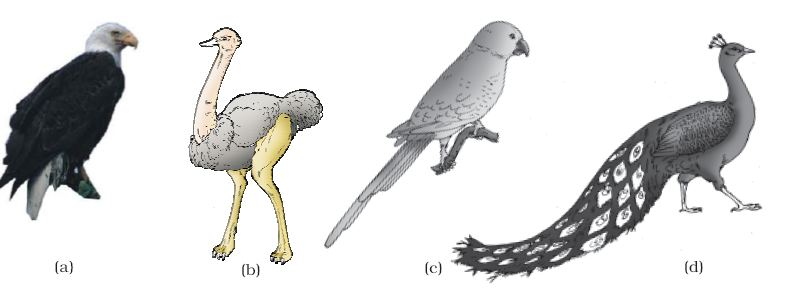
Examples: Corvus, Columba, Psittacula, Struthio, Pavo, Aptenodytes, Neophron
Flightless birds: Ostrich (Struthio), Rhea, Cassowary, Emu, Kiwi
Class 4: Mammalia
- Mammary glands, hair; external ear (pinna); sweat & sebaceous glands; diaphragm; pulmonary respiration.
- Bony endoskeleton; dicondylic skull; dentary lower jaw; heterodont, thecodont, diphyodont teeth.
- Four‑chambered heart; double circulation; no renal portal system; anucleate RBCs.
- Kidneys excrete urea (ureotelic). Highly developed sense organs; three ear ossicles; coiled cochlea.
- Sexual dimorphism common; testes often in scrotum; internal fertilization; parental care well developed.
| Mammalia | ||
|---|---|---|
| Prototheria (oviparous) | Theria (viviparous) | |
| Egg‑laying; without placenta — Ornithorhynchus | Give birth to young; with placenta | |
| Theria — Infraclasses | Metatheria | Eutheria |
| — | Pouched mammals; yolk‑sac placenta — e.g., Macropus | True placentals; allanto‑chorionic placenta — e.g., Pteropus, Balaenoptera |
Examples: Oviparous — Ornithorhynchus (platypus), Tachyglossus (echidna); Viviparous — Macropus (kangaroo), Pteropus (flying fox), Camel, Monkey, Rat, Dog, Cat, Elephant, Horse, Delphinus, Balaenoptera, Panthera tigris, Panthera leo
Levels of Organization
- Protoplasmic — all life activities in a single cell (Protozoa).
- Cellular — loose cell aggregates with some differentiation (sponges).
- Tissue — coordinated tissues (Cnidaria).
- Tissue‑organ — tissues aggregate into organs (first in Platyhelminthes).
- Organ‑system — organs work together (most animals).
Body Plans
- Cell aggregate — multicellular; cells act largely independently (Porifera).
- Blind sac — single opening for ingestion/egestion (Cnidaria, Platyhelminthes).
- Tube‑within‑a‑tube — outer body wall and inner digestive tract (Annelida → most higher groups).
Symmetry
- Spherical — e.g., Volvox, Heliozoa, Radiolaria.
- Radial — e.g., Hydra.
- Biradial — Ctenophora, many Anthozoans.
- Pentamerous radial — starfish.
- Bilateral — most higher animals.
- Asymmetry — Amoeba, many sponges.
Germ Layers
- Diploblastic — ectoderm & endoderm (Cnidaria).
- Triploblastic — ectoderm, mesoderm, endoderm (Bilateria).
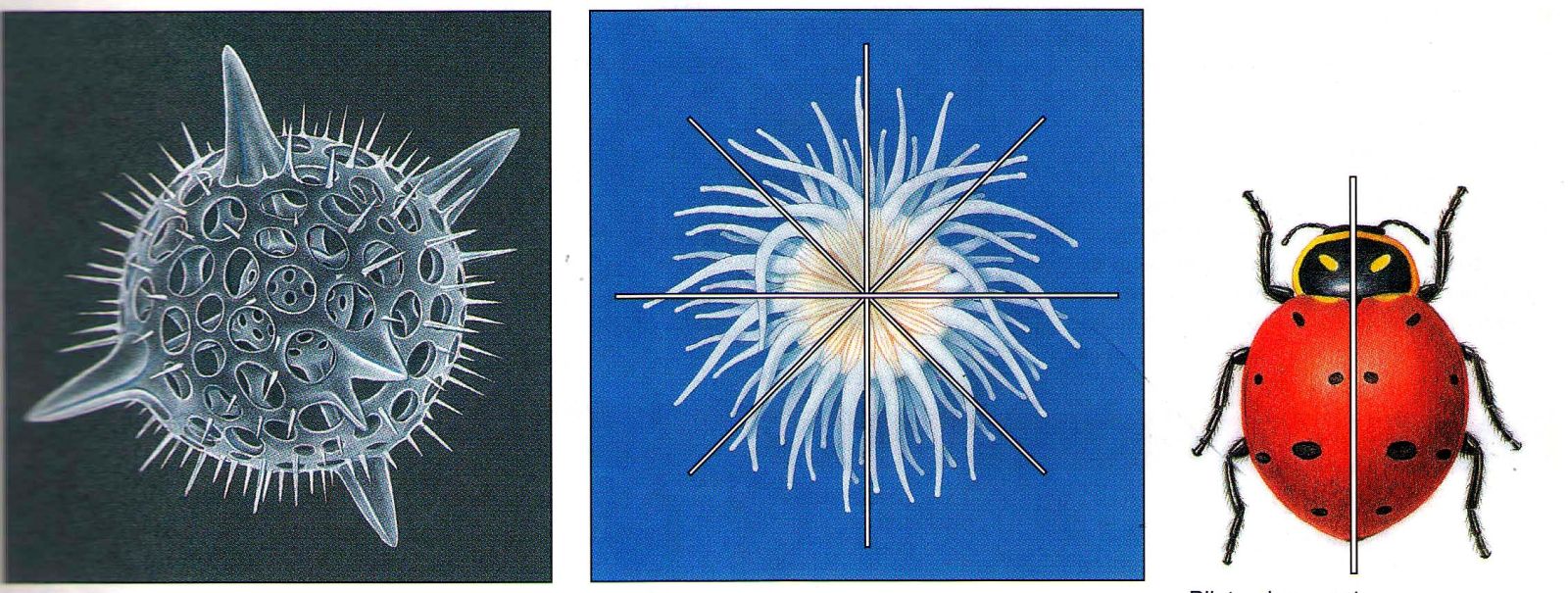
Body Cavity (Coelom)
- Acoelomates — no coelom (Cnidaria, Platyhelminthes).
- Pseudocoelomates — cavity not lined by mesoderm (Nemathelminthes).
- Eucoelomates — cavity lined by mesodermal peritoneum:
- Schizocoel — mesoderm splits (Annelids, Arthropods, Molluscs).
- Enterocoel — from archenteron pouches (Echinoderms, Chordates).

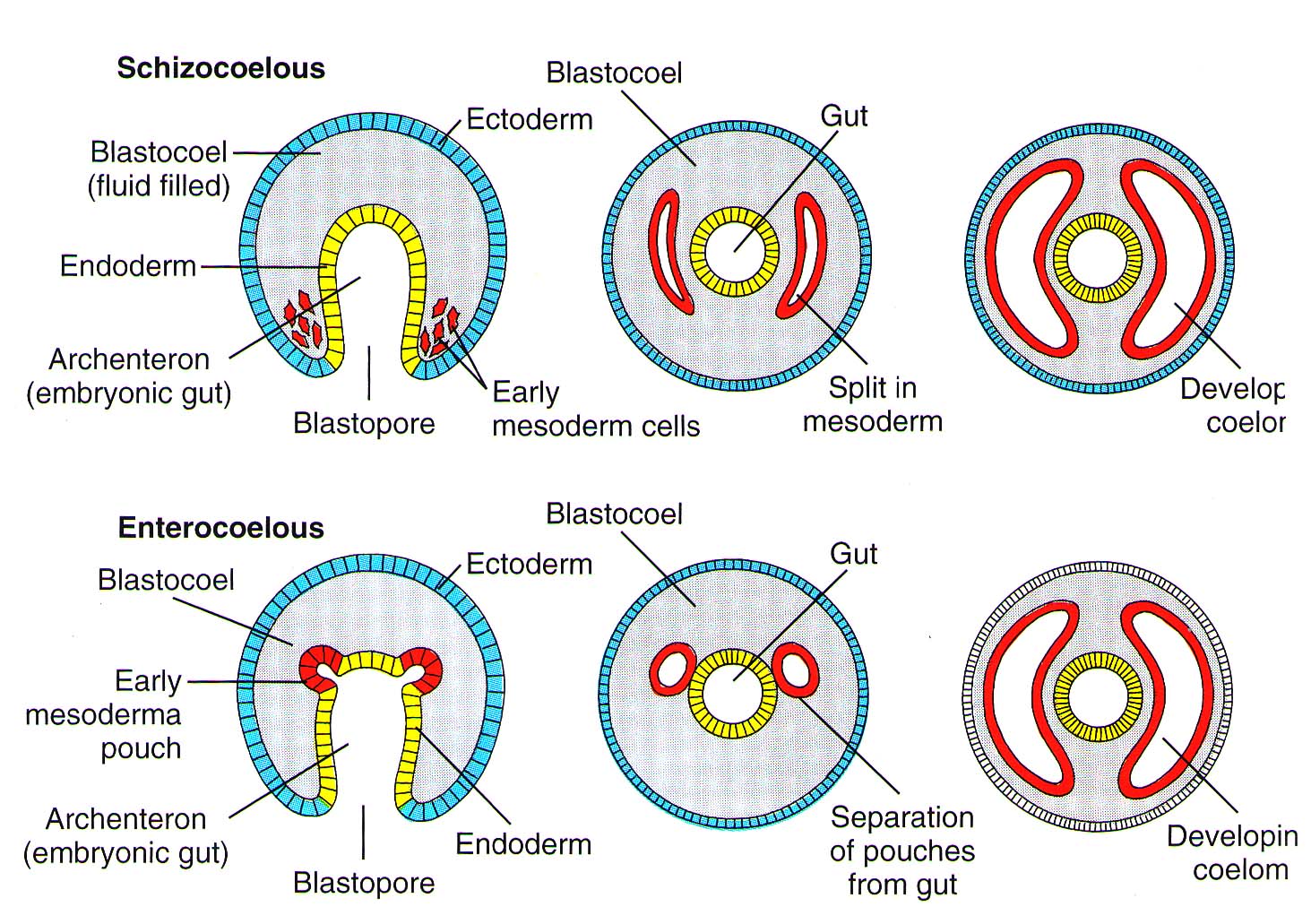
Segmentation (Metamerism)
Serial repetition of segments allows mobility and complexity.
- Annelida: internal & external segmentation
- Arthropoda: external segmentation only
- Chordata: internal segmentation only
Protostomes vs Deuterostomes
| Protostomes | Deuterostomes |
| Mouth from blastopore; spiral, determinate (mosaic) cleavage. | Mouth from secondary opening; blastopore → anus; radial, indeterminate (regulative) cleavage. |
Cephalization
Concentration of nervous tissue and sense organs in the head (seen in bilaterally symmetrical animals). Prominent from Platyhelminthes onward.
Chordates vs Non‑Chordates (Comparison)
| SN | Chordates | Non‑Chordates |
| 1 | Notochord present | Notochord absent |
| 2 | Dorsal, hollow, single CNS | Ventral, solid, double CNS |
| 3 | Pharynx with gill slits | Gill slits absent |
| 4 | Heart ventral | Heart dorsal (if present) |
| 5 | Post‑anal tail present | Post‑anal tail absent |
Notes: ~35 animal phyla exist; ~11 major. ~99% are invertebrates.
Tree of Animal Classification
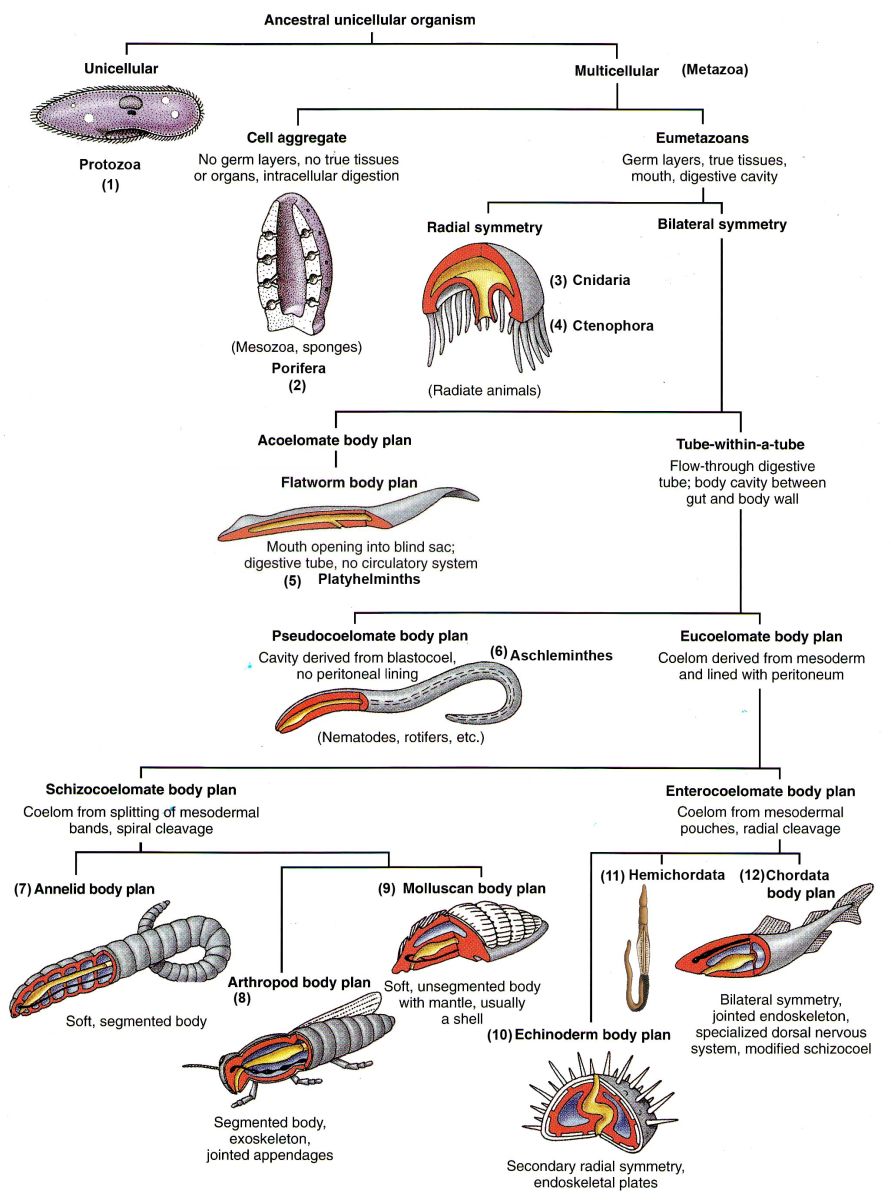
Comparative Study of Phyla
Habitat, Nutrition, Respiration, Circulation
| Phylum | Habitat | Nutrition | Respiration | Circulation |
| Porifera | All marine except Spongilla (freshwater) | Intracellular (choanocytes, amoebocytes) | Through body surface | Water canal system |
| Cnidaria | Mostly marine | Extra‑ then intracellular (gastrovascular cavity → nutritive muscle cells) | Through body surface | Gastrovascular circulation |
| Ctenophora | Exclusively marine | Extra‑ then intracellular | Through body surface | Gastrovascular circulation |
| Platyhelminthes | Mostly endoparasites | Blind‑sac; absent in some (tapeworms); both extra‑ & intracellular where present | Through body surface | Parenchymal circulation |
| Aschelminthes | Free‑living (aquatic/terrestrial) or parasitic | Complete gut; muscular pharynx; extracellular digestion | Through body surface | Pseudocoelomic circulation |
| Annelida | Aquatic (marine/freshwater) or terrestrial | Complete gut; extracellular digestion | Skin, gills, or parapodia | Usually closed BVS |
| Arthropoda | All habitats | — | Body surface, gills, tracheae, or book lungs | Open BVS |
| Mollusca | Terrestrial or aquatic | — | Gills or lungs or body surface | Open (haemocoel) |
| Echinodermata | Exclusively marine | — | Dermal branchiae, tube feet, bursae, etc. | Water vascular + hemal (open) |
Excretion, Movement, Nervous System, Reproduction
| Phylum | Excretion | Movement & Locomotion | Nervous System | Reproduction |
| Porifera | No organs; by surface | Spicules/spongin; mostly sessile | Absent | Asexual (gemmules) & sexual; indirect (parenchymula, amphiblastula) |
| Cnidaria | No organs; by surface | Sessile & free; circular & longitudinal muscles | Nerve nets | Sexual & asexual |
| Ctenophora | No organs; by surface | — | Diffuse nerve network | Hermaphrodite; external fertilization; indirect (cydippid larva) |
| Platyhelminthes | Flame cells | Longitudinal & circular muscles | Primitive ladder‑type | Mostly hermaphrodite; internal fertilization |
| Aschelminthes | H‑shaped canals; renette cells | Longitudinal muscles only | Circumpharyngeal ring; double ventral nerve cord | Dioecious; marked dimorphism; internal fertilization |
| Annelida | Nephridia; chloragogen cells; botryoidal tissue (leeches) | Circular & longitudinal muscles; parapodia/setae; hydrostatic skeleton | Circum‑esophageal ring; double ventral cord | Dioecious (Nereis) or monoecious (earthworm, leech); direct or indirect (trochophore) |
| Arthropoda | Malpighian tubules, green/coxal glands | Jointed legs | Segmental ganglia with connectives/commissures | Mostly dioecious; usually internal fertilization |
| Mollusca | Metanephridia; gills may aid | Muscular foot | Two nerve rings with longitudinal nerves | Dioecious (often); external or internal fertilization; indirect (glochidium/trochophore/veliger) or direct (cephalopods) |
| Echinodermata | No specialized organs | Tube feet; WVS | Poorly developed; no brain | Always dioecious; external fertilization; indirect (e.g., bipinnaria) |
Protozoa — General Characteristics
- Unicellular (acellular) organisms; single cell performs all vital activities; generally microscopic.
- Generally uninucleate (ciliates often multinucleate: macro‑ & micronucleus).
- Locomotion by pseudopodia (Sarcodina), flagella (Mastigophora), cilia (Ciliata); absent in Sporozoa.
- Nutrition: holophytic, holozoic, saprozoic, or parasitic.
- Contractile vacuoles in freshwater forms for osmoregulation and excretion.
- Reproduction: asexual (binary/multiple fission, budding, sporulation) and sexual (e.g., conjugation in Paramecium).
- Cysts form in adverse conditions; alternation of generations common; free‑living or parasitic.
Classification of Protozoa
| Class | Mastigophora | Rhizopoda / Sarcodina | Sporozoa | Ciliata |
| Characters | Flagella for locomotion/feeding; asexual reproduction by longitudinal binary fission | Body naked or with shell; pseudopodia for locomotion/feeding; asexual by binary/multiple fission | No locomotory organ in adult; sexual & asexual; exclusively parasitic | Firm pellicle; cilia; two nuclei (macro for metabolism, micro for sex); asexual by fission; sexual by conjugation |
| Examples | Euglena, Noctiluca, Trypanosoma (sleeping sickness), Leishmania donovani (kala‑azar), Giardia (dysentery) | Amoeba, Entamoeba (dysentery), Polystomella, Arcella | Plasmodium (malaria), Monocystis (earthworm), Eimeria, Sarcocystis | Paramecium, Opalina, Nyctotherus, Vorticella |
Parasitic Protozoans
Plasmodium
- Discovered in human RBCs by Charles Laveran; sexual stages in female Anopheles stomach (oocysts) observed by Ronald Ross.
- Four human species cause malaria; infective stage: sporozoite.
| # | Species | Disease |
| 1 | P. vivax | Benign tertian malaria |
| 2 | P. malariae | Quartan fever |
| 3 | P. falciparum | Malignant/Cerebral malaria; aestivo‑autumnal; blackwater fever |
| 4 | P. ovale | Mild tertian fever |
- Digenetic, intracellular parasite; asexual cycle (schizogony) in human liver/RBCs; sexual cycle (gametogony, sporogony) in mosquito.
Other Protozoan Parasites
- Entamoeba histolytica: monogenetic; in human large intestine; forms — trophozoite (pathogenic) and precystic/minuta (non‑pathogenic).
- E. gingivalis: non‑pathogenic; tartar of teeth; aggravates pyorrhea.
- Giardia (“grand old man of intestine”): upper small intestine; causes abdominal discomfort & diarrhoea.
- Trichomonas: buccalis (pyorrhea), vaginalis (leucorrhoea), hominis (diarrhoea).
- Trypanosoma: digenetic; blood/CSF; African sleeping sickness; vector: tsetse fly (Glossina palpalis) — T. gambiense, T. rhodesiense, T. cruzi (Chagas), T. brucei (nagana), T. evansi (surra).
- Leishmania donovani: digenetic; in RES (spleen, liver, WBC, bone marrow); causes kala‑azar; vector: sand fly (Phlebotomus argentipes). Other spp.: L. tropica (oriental sore), L. braziliensis (espundia).
Porifera
- Primitive multicellular, cell‑aggregate body plan; mostly asymmetrical; freshwater or marine; sessile; canal system with ostia → spongocoel → osculum; choanocytes line canals.
- Intracellular digestion; asexual (fragmentation, gemmules) and sexual reproduction; larvae: amphiblastula/parenchymula.
Classification (by skeleton)
| Class | Calcarea | Hexactinellida | Demospongiae |
| Character | Calcareous spicules | Six‑rayed siliceous spicules | Spongin fibres and/or siliceous spicules; sometimes neither |
| Example | Leucosolenia, Sycon | Euplectella, Hyalonema | Euspongia, Spongilla, Chalina |
Common Names
| Scientific Name | Common Name |
| Scypha | Urn/Crown sponge |
| Euplectella | Venus’s flower basket |
| Pheronema | Bowl sponge |
| Hyalonema | Glass‑rope sponge |
| Cliona | Boring (sulphur) sponge |
| Chalina | Mermaid’s gloves |
| Spongilla | Freshwater sponge |
| Euspongia | Bath sponge |
| Poterion | Neptune’s goblet |
| Hippospongia | Horse sponge |
| Hircinia | Horny sponge |
Cnidaria
- Diploblastic; tissue grade; blind‑sac plan; radial or biradial symmetry; gastrovascular cavity; mouth only.
- Tentacles around mouth; polymorphism: polyp (asexual, sessile) & medusa (sexual, free‑swimming).
- Have cnidoblasts (nematocysts) for anchorage/defense/prey capture; both extra‑ and intracellular digestion; nerve nets.
- Reproduction: budding (asexual) and sexual; planula/ephyra larvae; alternation of generations (metagenesis) in many.
Classification (by dominant form)
| Class | Hydrozoa | Scyphozoa | Anthozoa |
| Character | Polyp only or both; metagenesis | Medusa dominant | Polyp only; largest class (all marine) |
| Examples | Hydra, Obelia, Physalia, Millepora | Aurelia | Gorgonia, Adamsia, Astraea, corals |
Common Names
| Scientific | Common Name |
| Obelia | Sea fur |
| Millepora | Stinging coral |
| Physalia | Portuguese man‑of‑war |
| Velella | Little sail |
| Chiropsalmus | Sea wasp |
| Aurelia | Jellyfish |
| Metridium, Adamsia | Sea anemone |
| Pennatula | Sea pen |
| Corallium | Precious red coral |
| Meandrina | Brain coral |
| Tubipora | Organ‑pipe coral |
| Heliopora | Blue coral |
| Astraea | Stony coral |
| Virgularia | Walking stick |
| Fungia | Mushroom coral |
| Alcyonium | Dead man’s finger |
Frequently Asked Questions
The Animal Kingdom is a group scientists use to classify all animals. It includes tiny insects, huge whales, birds, reptiles, and more.
Animals are grouped based on their body structure, how they grow, and how they reproduce. Major groups include mammals, birds, reptiles, amphibians, fish, and invertebrates.
Vertebrates have a backbone (like humans, dogs, and birds). Invertebrates do not have a backbone (like insects, spiders, and jellyfish).
Mammals have hair or fur, give birth to live babies (mostly), and feed their young with milk.
Warm-blooded animals (like birds and mammals) keep their body temperature steady. Cold-blooded animals (like reptiles and fish) change their body temperature based on the environment.
It helps us understand how animals live, adapt, and interact with the environment, and how humans can protect them.